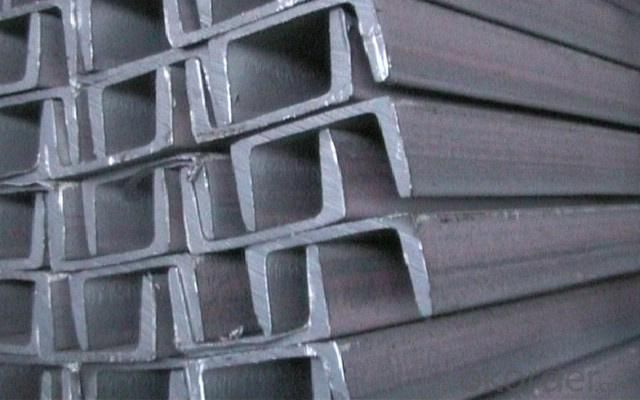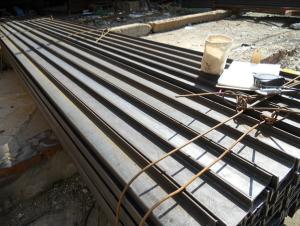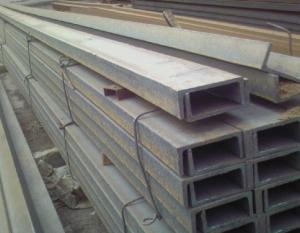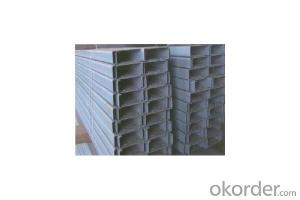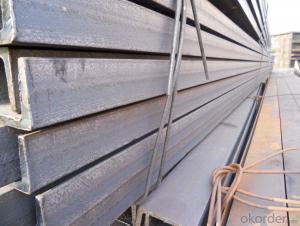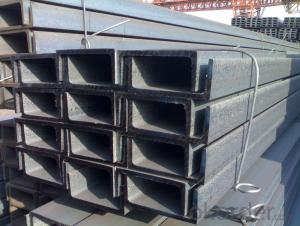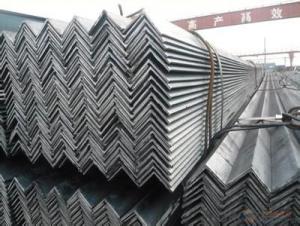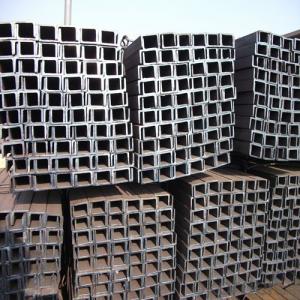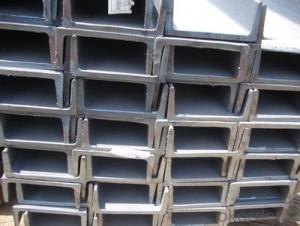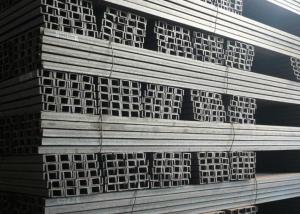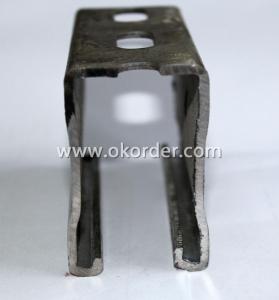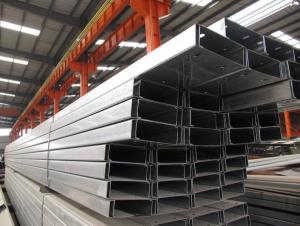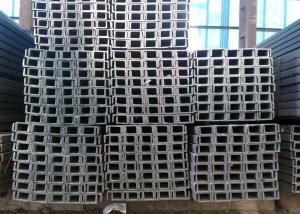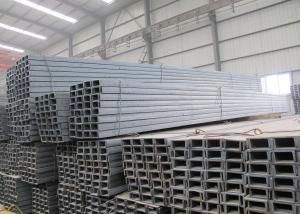High grade hot-rolled steel channel (Q235)
- Loading Port:
- Tianjin
- Payment Terms:
- TT OR LC
- Min Order Qty:
- 100 m.t.
- Supply Capability:
- 10000 m.t./month
OKorder Service Pledge
OKorder Financial Service
You Might Also Like
Channel is the section groove strip steel. Channel steel is used in the construction and machinery for carbon structural steel, steel steel section is complex, its sectional shapegroove. Channel steel is mainly used for building structure, the curtain wall engineering,mechanical equipment and vehicle manufacturing etc.. Request it has better welding, rivetingperformance and comprehensive mechanical properties in use. Steel billet production raw materials are carbon content not exceeding 0.25% of the carbon steel or low alloy steel billet.Product channel steel after hot forming, normalizing or hot-rolled state of delivery. Thespecifications to waist high (H) * leg width (b) * waist thick (d) millimeter number representation, such as 100*48*5.3, said waist height 100 mm, width of 48 mm steel legs,waist thickness was 5.3 mm, or 10# channel. Waist high the same channel, if there are several different wide legs and waist thickness also need to add a B C to be the difference in the types of the right, such as 25#a 25#b 25#c etc..
Classification
Channel can be divided into ordinary steel and light channel. Hot rolled ordinary channelspecifications for 5-40#. By both sides of supply and demand supply of hot rolled flexiblechannel protocol specifications for 6.5-30#. Channel steel is mainly used for building structure, vehicle manufacturing, other industrial structure and a fixed disk cabinet, steeloften used together with choices.
Channel steel according to shape and can be divided into 4 kinds: Leng Wan equilateral channels, Leng Wan scalene channel, Leng Wan edge channel, Leng Wan channel section with outer edge
In accordance with the steel structure theory, should be the channel steel flange force, that is to say the channel should be upright, not lying.
No.
With international chemical symbols for the element and its symbols to represent the chemical composition, in Arabia letter to indicate the contents of components:
Such as: China, Russia 12CrNi3A
Using a fixed number of bits to represent the steel series digital or digital; such as: the United States, Japan, 300 series, 400 series, 200 series;
Using the Latin alphabet and their sequence number, only that the use of.
The specification set
Channel steel specifications mainly used high (H), Tui Kuan (b), waist thickness (d) and othersize
Channel steel (3)
Said that at present domestic steel specifications from 5 to 40, that is, the correspondingheight of 5 to 1000px.
At the same height, light channel than common channel steel legs, waist narrow thin, light weight. 18 - 40, 5 - 16 for large channel, channel steel for medium channel. The importchannel indicate the actual size and related standards. Steel import and export orders generally is in determining the corresponding (carbon steel or low alloy steel) steel after,required the use specifications in the main. In addition to specifications, outside the channelwithout specific composition and performance series.
The delivery channel length is divided into fixed length, double length two, and the provisions of tolerance in the corresponding standard. The domestic channel length selection scope according to the specifications of different divided into 5 12M, 5 19m, 6 19m three. The importchannel length selection is generally in the range 6 to 15m.
China's steel imports more than it exports. Simple import and along with the complete engineering importing two channels. In recent years, China's coastal big port (Dalian, Tianjin,Qinhuangdao, Lianyungang etc.) in the new, expansion of oil, coal, grain and other bulkimport and export commodity automatic loading and unloading in the project, with the mainequipment is introduced at the same time, imports large channel is on the increase. The main production countries and regions as Japan, Russia, Western europe. Export channel mainly to Hong Kong and macao.
7 the appearance requirements
Surface quality and geometry of the channel of the allowable deviation are specified in the standard. General requirement of surface shall not use harmful defects, there shall be nosignificant reverse, provisions of channel wave bending (camber) related to allow surface shape value and various specifications channel parameters (h, B, D, t etc.) numerical,tolerance. The main performance of channel geometry is not true: angle, leg extended legand etc..
8 the main origin
Channel of China is mainly composed of several steel production, steel, iron, Tang Gang,Huang te, Maanshan Iron and steel, Bao Steel, Xuanhua Steel, Japan etc..
- Q: Are steel channels suitable for supporting overhead equipment or structures?
- Yes, steel channels are suitable for supporting overhead equipment or structures. Steel channels are known for their high strength and durability, making them ideal for providing structural support. They can effectively bear heavy loads, making them a reliable choice for supporting overhead equipment or structures.
- Q: What are the different material specifications for steel channels?
- There are various material specifications for steel channels, such as the American Standard Channels (C-shape), which are designated by their height and weight per foot. Another specification is the European Standard Channels (U-shape), which are identified by their dimensions and weight per meter. Additionally, steel channels can be produced in different grades, such as A36, A572, and A588, which determine their mechanical properties and suitability for specific applications.
- Q: Are steel channels suitable for earthquake-prone regions?
- Yes, steel channels are suitable for earthquake-prone regions. Steel is a strong and flexible material that can withstand seismic forces and provide structural stability during earthquakes. The use of steel channels in construction allows for better resistance to lateral loads and enhances the overall resilience of buildings in earthquake-prone areas.
- Q: How do steel channels contribute to moisture control in buildings?
- There are several ways in which steel channels contribute to moisture control in buildings. To begin with, steel channels are frequently utilized as part of the building envelope, particularly in the construction of walls and roofs. These channels are designed to create a barrier that prevents moisture from infiltrating. When installed correctly, they effectively prevent rainwater, snow, and other forms of precipitation from seeping into the building. This protection safeguards the interior from potential water damage and the growth of mold. Additionally, steel channels can be employed in conjunction with waterproofing systems to enhance moisture control. Waterproofing membranes or coatings are applied to the surface of the channels, adding an extra layer of defense against moisture penetration. This is especially valuable in regions that experience heavy rainfall or high levels of humidity. Moreover, steel channels can be integrated into the building's drainage system. They are frequently used to guide rainwater away from the building and into the appropriate drainage channels or downspouts. By effectively managing the runoff of rainwater, steel channels help prevent water accumulation around the building. This reduces the risk of moisture-related problems like leaks and damage to the foundation. Lastly, steel channels contribute to moisture control by facilitating proper ventilation within the building. Adequate airflow is vital for regulating moisture levels indoors. Steel channels can be incorporated into the ventilation system to allow for the exchange of air and hinder the buildup of excessive humidity. This is significant because excessive humidity can lead to condensation and subsequent moisture issues. In conclusion, steel channels play a crucial role in moisture control in buildings. They establish a protective barrier against moisture infiltration, can be combined with waterproofing systems, aid in managing rainwater runoff, and support proper ventilation. By addressing these key aspects, steel channels contribute to maintaining a dry and healthy indoor environment while also extending the lifespan of the building.
- Q: How do steel channels contribute to the overall stability of a building?
- Steel channels contribute to the overall stability of a building by providing structural support and load-bearing capabilities. They are often used as beams or columns in construction, helping to distribute the weight of the building evenly and efficiently. The rigid and durable nature of steel channels enhances the building's ability to withstand external forces such as wind, earthquakes, or heavy loads, ensuring its stability and structural integrity.
- Q: Can steel channels be used in solar panel installations?
- Solar panel installations can utilize steel channels. These channels, also referred to as steel C channels or steel U channels, are commonly employed in construction and industrial settings due to their strength, durability, and versatility. In the context of solar panel installations, steel channels can serve as robust support structures for mounting solar panels on rooftops or in ground-mounted systems. Steel channels offer a stable framework capable of withstanding the weight of solar panels and various weather conditions. They can be easily customized and fabricated to meet specific installation requirements, such as the size and angle of the solar panels. Moreover, steel channels can be galvanized or coated to provide corrosion resistance, ensuring the longevity of the solar panel installation. Additionally, steel channels provide flexibility in terms of design and layout. They can be seamlessly integrated with other mounting systems and components, including rails, brackets, and clamps, enabling efficient and secure solar panel installations. The adaptability of steel channels makes them suitable for both residential and commercial solar panel projects. To summarize, steel channels are a practical choice for solar panel installations due to their strength, durability, versatility, and compatibility with other mounting systems. They provide a sturdy foundation for mounting solar panels, guaranteeing a stable and efficient solar energy system.
- Q: Can steel channels be used for solar panel mounting systems?
- Yes, steel channels can be used for solar panel mounting systems. Steel channels provide a sturdy and durable framework for mounting solar panels. They are able to withstand the weight of the panels and provide a stable base for installation. Additionally, steel channels can be easily customized and adjusted to fit specific project requirements, making them a versatile option for solar panel mounting systems. The strength and rigidity of steel channels also ensure that the solar panels are securely held in place, even in harsh weather conditions. Overall, steel channels are a popular choice for solar panel mounting systems due to their strength, durability, and versatility.
- Q: #10 how to anchor the channel steel on the foundation, the anchor bars generally choose how much?
- This needs to be determined according to the force and the form of the structure, and can not be done at will.
- Q: Are steel channels suitable for electrical installations?
- Yes, steel channels are suitable for electrical installations. Steel channels are commonly used for cable management and support in electrical installations due to their strength and durability. They provide a reliable and secure method for routing and protecting electrical cables, reducing the risk of damage and ensuring a neat and organized installation. Steel channels also offer excellent resistance to fire and impact, making them a safe choice for electrical applications. Additionally, they are available in various sizes and configurations, allowing for flexibility in designing and customizing electrical systems.
- Q: What are the different methods of insulation for steel channels?
- There are several methods of insulation for steel channels, each offering unique advantages and applications. Some of the most common methods include: 1. Thermal insulation: This method involves using materials with low thermal conductivity to reduce heat transfer. Common thermal insulation materials for steel channels include mineral wool, fiberglass, foam insulation, and reflective barriers. These materials are effective in preventing heat loss or gain, ensuring energy efficiency and maintaining a comfortable temperature within the channel. 2. Spray foam insulation: This technique involves applying a liquid foam insulation material on the surface of the steel channel. The foam rapidly expands and solidifies, creating a seamless and airtight insulation layer. Spray foam insulation provides excellent thermal and moisture resistance, as well as soundproofing properties. It adheres well to irregular shapes and can easily fill gaps and cracks, making it a versatile insulation method. 3. Insulated panels: Insulated panels are pre-fabricated panels consisting of an insulating core sandwiched between two metal skins. These panels can be directly attached to steel channels, providing an instant and efficient insulation solution. Insulated panels offer excellent thermal performance, noise reduction, and fire resistance. They are also lightweight and easy to install, making them a popular choice for commercial and industrial applications. 4. Insulation wraps: Insulation wraps are flexible materials that can be wrapped around steel channels to provide insulation. These wraps are typically made of fiberglass or mineral wool and are available in various thicknesses and widths. Insulation wraps provide thermal and acoustic insulation, as well as protection against corrosion and condensation. They are easy to install and can be customized to fit different channel sizes and shapes. 5. Reflective insulation: Reflective insulation involves using materials such as aluminum foil to reflect radiant heat away from the steel channel. This method is particularly effective in hot climates, as it helps to reduce heat gain. Reflective insulation can be installed as sheets, rolls, or panels and is often combined with other insulation methods to enhance overall thermal efficiency. 6. Ceramic insulation coatings: Ceramic insulation coatings are applied directly onto the surface of the steel channel. These coatings consist of ceramic particles suspended in a binder, creating a heat-resistant barrier. Ceramic insulation coatings provide excellent thermal insulation and can withstand high temperatures. They are commonly used in industrial settings where extreme heat or fire protection is required. Overall, the choice of insulation method for steel channels depends on factors such as the desired thermal performance, budget, installation requirements, and specific application. It is important to consider the unique properties and benefits of each method to select the most suitable insulation solution.
Send your message to us
High grade hot-rolled steel channel (Q235)
- Loading Port:
- Tianjin
- Payment Terms:
- TT OR LC
- Min Order Qty:
- 100 m.t.
- Supply Capability:
- 10000 m.t./month
OKorder Service Pledge
OKorder Financial Service
Similar products
Hot products
Hot Searches
Related keywords



